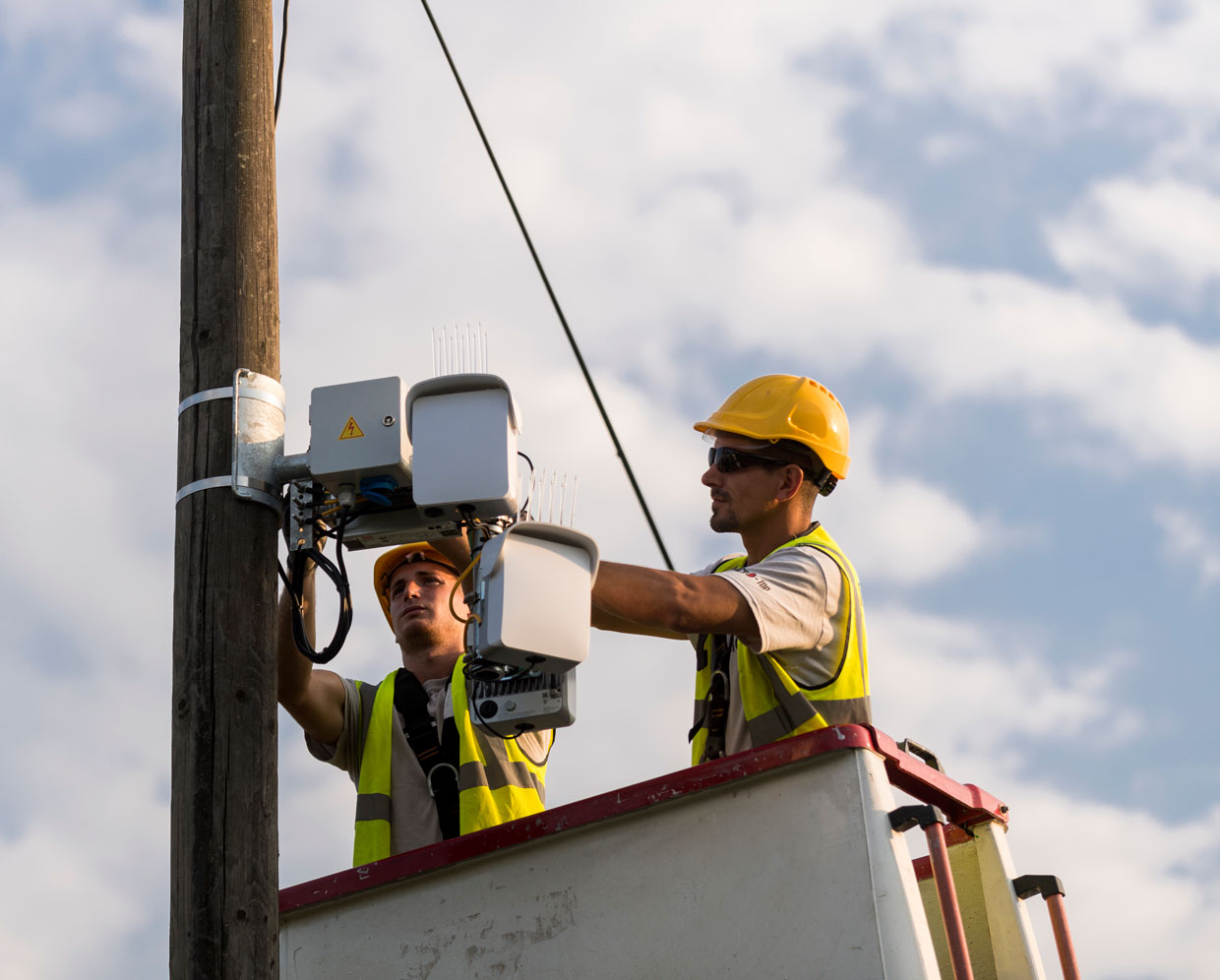Facebook's Terragraph Technology Shifts from Testing to Commercial Use
- Transfer
A set of programs allows groups of small wireless base stations operating at 60 GHz to communicate with each other

Wireless world: technicians in Mikebud (Hungary) install small stations with Terragraph support for tests that began in May 2018.
For years, Facebook has been developing a technology that improves the organization of data and its transmission over wireless networks. Now this technology is being integrated into commercially available small format base stations at 60 GHz. And if the communication providers connect to the project, he will soon be able to help connect homes and businesses around the world to wirelessly connect to the Internet.
Facebook technology called Terragraph allows you to combine base stations into groups transmitting at a frequency of 60 GHz and autonomously controlling and distributing traffic among themselves. If one base station stops working, the other immediately takes on its tasks - and they can work together to find the most effective way of passing information.
Already several equipment manufacturers, including Cambium Networks , Common Networks , Nokia and Qualcomm , have agreed to release commercial devices that integrate Terragraph. His most recent presentation took place in February at the MWC trade show.in Barcelona. If the technology can work as it should, Terragraph will make Internet access faster and cheaper at deployment sites.
Increasingly, the broadband Internet, which used to be distributed over expensive fiber-optic cables buried in the ground, comes to homes and businesses by air. To this end, telecom operators are eyeing high-frequency ranges whose bandwidth is higher than that of loaded low frequencies that have long been used for consumer electronics.
Facebook is interested in the V-band , which is usually called simply 60 GHz, although technically speaking, it extends from 40 to 75 GHz. In many countries, he is not busy with anyone, which means he is free to use.
Although indoor installation equipment supporting 60 GHz as an alternative to WiFi has been around for a long time, street stations are only appearing now. Many Internet service providers are thinking of using 60 GHz to close the gap between existing infrastructure and new places that they would like to cover, or to increase the capacity of already covered places.
“This is definitely interesting,” says Svetank Kumar Saha , a researcher and Ph.D. in computer science at Buffalo University (New York), studying the effectiveness of 60 GHz consumer equipment for indoor installation. - Many people have encountered problems with the commercialization of 60 GHz. There was a lot of talk on this subject. ”
One of the problems is that millimeter wavelength signals (from 30 to 300 GHz) do not propagate as far as lower frequency signals, are easily absorbed by rain and foliage, and do not pass through walls and windows.
To get around these problems, providers usually use fixed wireless networks in which base stations transmit a signal to a fixed receiver located outside the building. And from there, the data is already coming through Ethernet cables.
Last year, Facebook collaborated with Deutsche Telekom to test the Terragraph system in two Hungarian villages. In the first testtechnicians connected 100 homes to the network. Terragraph allowed residents to use the Internet at an average speed of 500 Mbit / s, instead of 5-10 Mbit / s received through DSL. Facebook is now completing trials with operators in Brazil, Greece, Hungary, Indonesia, Malaysia, and the United States.
The technology consists of a set of software based on IEEE 802.11ay , and includes features such as time-division multiple access, which divides the channel into time periods during which different bases can transmit signals, quickly replacing each other. In the seven-level network model, OSI Terragraph operates at the third level, transferring information between IP addresses.
Facebook’s Terragraph system used its experience of transmitting data on its fiber optic channel and applied it to wireless networks, says Chetan Hebbala , senior director of Cambium. In 2017, the project completed a full cycle when Facebook made the underlying routing software free. This program, Open / R , was originally intended for Terragraph, but now it is also used to transfer information between Facebook data centers.
Technology still has its limitations. Each base station can transmit a signal at a distance of up to 250 m, and the entire transmission should be on a line of sight that is not blocked by foliage, walls or other obstacles. Anouj Madan, Facebook's product manager, said the company experienced the Terragraph in the rain and snow, and that the weather “has so far not created a problem” for speed. But Hebbala says that just in case, many 60 GHz stations are designed so that, with heavy losses, they can temporarily switch to standard 5 GHz or 2.4 GHz frequencies for WiFi.
A Sprint spokesman said the company plans to test Terragraph equipment and is exploring issues related to the 60 GHz band for its network. A representative from AT&T said the company is conducting laboratory tests of 60 GHz frequencies, but so far it has no plans to include this range in existing networks.
Buffalo University's Saha is optimistic about Terragraph’s chances of entering the world. “As a result, companies will look at the cost of technology, and if it is less than that of optical fiber, then they will definitely use it,” he says.
Hebbala says his company's first Terragraph-enabled base station is now in a “development and design phase," and is likely to appear later this year. The company's goal is to offer Terragraph as a software feature that is easy to enable or reconfigure remotely. “I hope that when we talk in six months, I can talk about the pilot launches and test deployments with the first customers,” he says.
